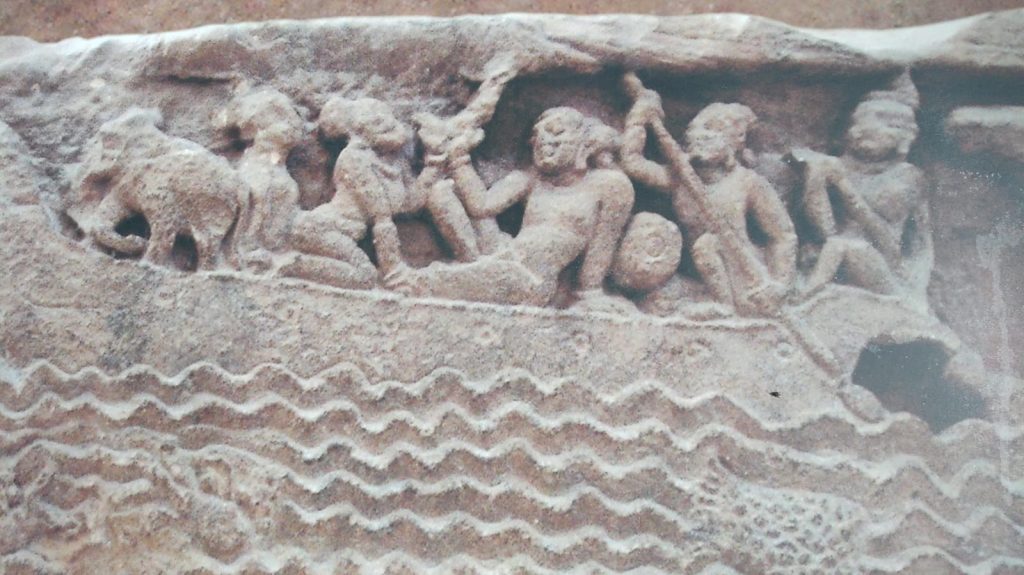It’s a foggy morning with hazy visibility. Thousands of traders prepare to board their massive ships. With moist eyes, their loved ones are there to wish them luck so the sailors can navigate the unexpectedness of seas. The sails of fat-bellied ships go upward and flap signalling that time has come to bid adieu to the voyagers. There are celebrations at the port as the ships lift their anchors to begin their journey to faraway lands on pulsing blue waters of Bay of Bengal.
Pic – Indian Museum Calcutta
This might have been the scene at a typical harbour in ancient Odisha on the full moon day in the month of Kartika. It is reasonable to believe that the ‘Sadhavas’ (Odia marine traders) took advantage of the outgoing North East monsoon between October and November to set their sails from ports in Kalinga to Suvarnabhumi (the Land of Gold), i.e., present-day South-east Asia. Modern-day festivals such as Bali Yatra and Khudurukuni corroborate this. While Bali Yatra marks the beginning of the voyage, Khudurukuni is celebrated as a mark of the return of traders.
(Pic – Odisha State Maritime museum in Cuttack)
This is well-known that Odia traders had commercial relationships with South-east Asian countries for centuries. Many, however, would be surprised to know of historical records of Odia maritime conquests that predate Chola empire under Rajendra Chola (Conquest of Pegu 1023–1025 CE, Conquest of the Srivijaya Empire 1025 CE)- which is often attributed as the first Indian empire outside the country.
If we look at history of maritime conquests through the ages, a distinct pattern emerges. New territories were often discovered through military expeditions which later gave way to trade relationships and later culminated in cultural links. We have already referred to modern-day Odisha’s trade links with China, South-east Asia and Sri Lanka. Cultural links with these regions are also well-known as can be referred from King Ashoka’s daughter Sanghamitta’s voyage to Sri Lanka in third century BCE to modern architectural and naming references across South-east Asia that showcase their links with Odisha.
But, was there any military conquest by Odias that established the trade and cultural linkage?
Historian RK Kanchan writes about the colonisation of Pegu in Burma (Myanmar) by the royal family of Kalinga in third century BCE. After the invasion of Ashoka, there might have been a mass migration from the coastal belt of Kalinga to Burma via sea route.
Many scholars mention that the kingdom of Funan (Cambodia) was raised by the people of Kalinga. According to Chinese sources, a Kaundinya Brahmana established the Funan kingdom in the first century CE. Kaundinya Brahmanas are considered to have emerged from the Mahendra mountain region in Odisha.
Historian HB Sarkar has written about the probability of Java’s colonisation by Kalinga. There is a place called Holing in Java, which is assumed to be a Chinese transcription (during Tang dynasty 618 to 907 CE) of Kalinga. A mass migration from Kalinga to Java is also recounted in several legends.
Historian Sunil Kumar Patnaik, in his book ‘Studies in Maritime Heritage of Odisha’, mentions a king called Jayabhaya who claimed to be a descendant of a Kalinga family. Additionally, Javanese records also mention Aji Saka, who hailed from Kalinga and was one of the most prominent colonisers of Java.
Historian Sarat Chandra Behera, in his book Rise and Fall of the Sailodvabas, has mentioned the relationship between the ruling Sailodvabas of Kongoda and the Sailendra dynasty of the Srivijaya kingdom in Sumatra.
According to historical records of Sailodvaba dynasty, which ruled Kongoda (the region between Mahanadi and Rushikulya River) from sixth century CE to eighth century CE, King Madhavaraja was expelled to Bali with 20,000 soldiers in eighth century CE. Later, he raised his kingdom in Bali through multiple conquests.
On reasonable ground, it can be assumed that due to the invasion of Bhaumakars from the northern part of Odisha and the hostile relations with the South Koshala kingdom in the west, the Sailodvabas were banished to escape via a sea route in eastward direction. Many scholars opine that this migration might have led to the formation of Sailendra dynasty in Sumatra. However, more research is necessary to corroborate the linkage.
Apart from that, Ceylon and Kalinga had cultural ties since fifth century BCE. In the Ceylonese records, a king called Vijaya — who was the son of Simhabahu of Simhapura in Kalinga — is described as the first ruler of Ceylon in third century BCE.
From all these accounts, it can be deduced that the mariners of Kalinga played a major role in colonising Southeast Asian countries much before the Cholas. However, the lack of thorough research has pushed many facts linked with Odisha’s maritime heritage into the dungeons of darkness.
(Pic – Patit Mandal)
Meticulous micro research and publicity of cultural resources are needed to give global recognition to several ancient ports in Odisha, such as Manikapatna, Palur, Bramhavana, and so on. Otherwise, as Nigerian novelist Chinua Achebe once said, “Until the lions have their own historians, the history of the hunt will always glorify the hunter.”
By Patit Mandal, OP
